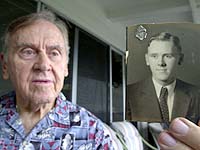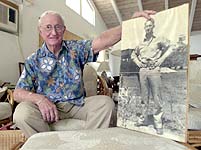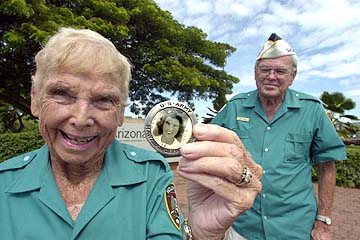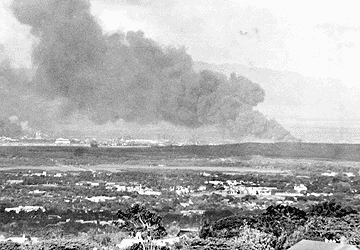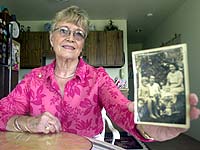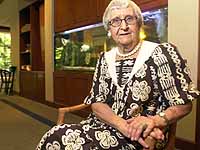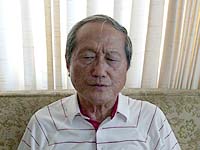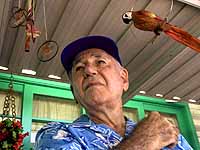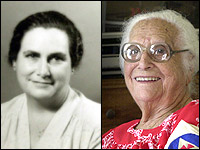 |

|
Story by Will Hoover Shipyard workers enjoying a day off. Mothers making breakfast for their babies. Children in church pews. Boys playing marbles on the sidewalk in Kaimuki. The attack on military targets in Hawai'i on Dec. 7 brought unbelievable horrors witnessed by soldiers, airmen, Marines and sailors at military bases and along Battleship Row where the warships of the Pacific Fleet slumbered. But the unexpected appearance of planes overhead and realization they were not taking part in familiar war games marked the beginning of a life changed for every civilian in Hawai'i. As Pearl Harbor survivors, many recall vivid images from that Sunday morning. Edmond Jones, Levi Moe Faufata Jr., Griffith Conradt, Thomas Unger, and Bill and Ruth Cope are but six who — 60 years later — look back to that day and remember. Their stories are of pain, loss, irony, anger, despair and love. Their memories are the stories of scores of others bound by the attack on Pearl Harbor. 'Terrible day' Edmond Jones had a ringside seat to history. Nursing a hangover from excessive revelry and Primo beer the evening of Dec. 6, the 22-year-old stood on a rural hillside near his home in Kane'ohe the morning after, watching America enter World War II. The panoramic scene that unfolded before him started with a surrealistic wave of low-flying Japanese fighters streaming toward the naval air station across Kane'ohe Bay. Suddenly, the planes began to fire. "I couldn't believe my eyes," he said. Later, after he had rushed about sounding a frantic warning to neighbors and family, Jones turned his eyes to the skies above the Ko'olau range and, for one brief moment, witnessed what few others saw that fateful morning — an outright American victory. The scene was a dogfight between a Japanese Zero and a P-40 fighter that ended with the American plane shooting down its target, which nosedived into the ocean beside Mokoli'i (Chinaman's Hat). It was just the beginning of a "terrible day." Death struck closer to home when four shipyard riggers were killed in their car on Judd Street en route to Pearl Harbor. The victims were John Adams and his father, Joseph Adams; their uncle, Joseph McCabe; and McCabe's nephew David Kahookele. | See civilians, Page 11 "They were my cousins," said Jones. "Joe McCabe was Irish Hawaiian. I called him 'Uncle Joe.' He was a good man. So was 'Uncle Joe' Adams," said Jones at his Kane'ohe home. "All four were good men, and they're all buried right down the road." Initial reports said three civilians were killed when their car was hit by a Japanese bomb, but in fact the four were killed when the car was hit by errant U.S. anti-aircraft fire. A photo of the shell-riddled car — victims still inside — was taken by Look magazine photographer Patricia Robbins and appeared in hundreds of publications. That photo has become one of the more recognizable shots from the Day of Infamy. Two months to the day after Dec. 7, Jones was inducted into the Army. He remembers feeling overwhelming anger. He wanted to seek revenge. He served in the 298th Infantry to the war's end, learning on his way to Saipan that the United States had dropped an atomic bomb. But it is memories of Dec. 7 that have been Jones' constant companion for the past 60 years. He never forgets. He wonders what life might have been like if the attack hadn't happened. "I've had a very exciting life," said Jones. "But I've learned to get over my anger." Somehow, talking about it is important. There are lessons to be learned. There are parallels that can be made with the events of Sept. 11, 2001. So he tells his friends, his children — he tells anyone who'll listen. Then he lets them draw their own conclusions. 'I only feel sorrow' One month before the attack, Levi Moe Faufata Jr. and his family moved into their lower 'Alewa Heights home. When the boy awoke that Sunday, something tremendous was happening outside his bedroom window. Through the eyes of a 14-year-old, the sight of swooping planes and fiery explosions was nothing short of thrilling. Today, at 74, memories can be so painful for the normally jovial Faufata that he finds himself barely able to speak of them at times. Faufata, the oldest of five siblings, recalls dashing from the window to the breakfast table for a quick bite of French toast, then back to the window again to watch the "show." "I thought I had a pretty good view," he said. "I could see planes going over. I didn't know they were Japanese. I thought it was military maneuvers. It was so realistic — planes flying low and fire shooting up. "But then, my dad turned on the radio. That's when we found out. The announcer said, 'This is the real McCoy!'" A call went out for all Pearl Harbor workers to report for duty immediately. Faufata's father, a Pearl Harbor pipe fitter, sped off in the family car. Faufata's mother busied herself with rounding up emergency supplies. Faufata raced on foot down the road toward Judd Street to get a better view, followed by others from the neighborhood. "All of us were watching this Japanese plane fly over. And we found out later that Americans were shooting at that plane, and they didn't fuse one of their shells correctly. So instead of bursting in the air, it hit this car and blew up." As the stunned teenager felt the concussion from the tremendous explosion, he watched the shrapnel-riddled automobile hurtle diagonally across the street and slam violently to a halt. Two of Faufata's uncles, Joseph and Fata Kekahuna, rushed across the street to help the four men inside, three of whom already were dead, one mortally wounded. Faufata took off for the house when he heard his 12-year-old sister, Matilda, who had been standing at the front door, cry out in pain. Although he didn't realize it, she had been struck in the chest by a shell fragment. He found his sister on the floor near the kitchen when he got inside. His mother came in from outdoors, knelt down and cradled the girl in her arms. "My sister was dead," he said. "Mom said a prayer." Less vivid are memories of the confusion and emotions from the rest of that day. He recalls his father's return that evening, and his father's sorrow and anger after learning of his daughter's death. There are memories of the family praying together, and of them spending that night huddled in darkness in the garage. There followed weeks, months and then years of nightly blackouts, martial law and very regimented living. By the time the war was over, Faufata had joined the Army and was part of the U.S. occupation forces in Japan. Faufata retuned from Asia in December 1951 with a Japanese bride, and he and Yoko had three children. His career in the military lasted 20 years, 6 months and 16 days. But there would be one other connection to Pearl Harbor, creating a memory that would never go away. It happened on Aug. 21, 1958, in Middle Loch, 200 yards offshore. Faufata and his two sons, Omar, 6, and Bruce, 4, were fishing in a rowboat. They had fished there before, but on this morning, their boat was struck broadside by a 56-foot Navy landing craft. Neither Faufata nor Omar was injured. But Bruce was killed instantly. "It's uncanny," said Faufata. He doesn't dwell on the Pearl Harbor connection to the tragic events of his life. Sometime though — usually around Dec. 7 — the associations, and old emotions, are unavoidable. "Mainly," he said softly, "I only feel sorrow."
Griffith Conradt's account begins at 7:55 a.m. "There were four of us eating breakfast — my father, Frederick, my mother, Henrietta, my brother, Adrian, and myself. We were living up on Fourth Avenue in Kaimuki, and we could see all the smoke at Pearl Harbor. We had a view from our hill." He was 18. "Adrian had to leave right away because the Army called all personnel, and my brother was stationed at Schofield Barracks." By midday, O'ahu was under martial law. Conradt and his folks spent the day indoors, covering windows to comply with blackout orders. His parents, he said, were shaken and talked about the brazen attack on Pearl Harbor. But for this family, the biggest shock came the next morning, when federal agents and military men with guns arrived to arrest Conradt's father and take him away. For months, the family was allowed no contact with him. No reason ever was given for his arrest, other than that his name was on a list. Frederick Conradt had been born on Kaua'i, raised in Samoa and had never set foot in Germany. He spoke fluent English and Samoan, but little German. In his early 20s, he moved from Samoa to O'ahu and later started a successful lauhala-mat importing business. But he was of German ancestry. That, apparently, was all it took. Records would later reveal that 12 days after he was taken into custody, military authorities found no reason to hold him. Nevertheless, he was confined at the Sand Island Detention Center until June 22, 1942. "My dad was never bitter about what happened to him," said Conradt. "He just said it was too bad, because his business went downhill after that. But my dad always praised everything American. He said this was the best country in the world. He always said the young American soldiers guarding him were very nice." Griffith Conradt, who had a job as a bank teller, added his income to the family coffers. For two years he also served in the Businessmen's Military Training Corps, guarding vital civilian installations such as radio towers and electrical power stations. Then, after he was drafted into the Army in 1944, he was sent off to fight Germans. He was lucky and never saw combat. Conradt was in France when the war ended. Had it not been for Dec. 7, Conradt says, he might have graduated from the University of Hawai'i. Naturally, his father's patriotism would never have been in doubt. There would have been no cloud of suspicion over the household. The family business might have survived. After the war, Conradt was a mortgage specialist for several Honolulu financial institutions, retiring in 1987 as a senior vice president with First Federal Savings and Loan. He and his wife, Virginia, raised two children. Like his late father, mother and brother Adrian, Conradt says he has never been bitter. It annoys him, though, that unlike families of Japanese Americans who were rounded up and put in internment camps, his family never received redress from the government. "A letter of apology would be enough," he said. (Note: Griffith Conradt died at his home on Nov. 28.)
It has been six decades, and Thomas Unger still marvels at the lingering incongruities. "There's so much irony," he said, shaking his head as he recalled the events that ushered an 18-year-old, fresh-out-of-high-school football player into a moment that became the world's focal point. For Unger, who lived across from Honolulu's Roosevelt High School, the day began with unfathomable confusion outside — the spectacle of explosions and enemy aircraft overhead, the sudden horror of being attacked by a foreign power. Unger reacted instinctively. On the family radio, he heard a Red Cross bulletin requesting volunteers. So he jumped into his Ford Model-A pickup and burned rubber all the way to 'Iolani Palace. There, he hopped aboard a flatbed truck bound for Hickam Field. He helped rescue a wounded soldier from a shelled guardhouse and then began toting water buckets to a makeshift infirmary. Before that morning. Unger had never seen a corpse. By the time the sun went down, the exhausted youth had spent much of the day hauling bodies to a temporary morgue at Fort Shafter. That night, he slept beneath a military vehicle on the palace grounds. Within two days, he had been sworn into the Hawai'i Territorial Guard, and after a gruff Army captain spotted the strapping athlete, Unger was assigned to special duty at Sand Island. Surrounded by high fences and hastily strung barbed wire, he helped establish America's first prisoner-of-war camp since the Civil War. At one point, he stood watch over the nation's first Japanese POW of World War II, Kazuo Sakamaki. "Ensign Sakamaki was off a two-man mini-submarine captured at Bellows," he said. "The other crewman committed suicide." Up close, Unger noticed that Sakamaki's face didn't seem nearly as sinister as those of the enemy pilots who had whizzed over the top of the Unger home. "He just looked like someone who could fit right into the population downtown. He seemed like a nice guy." Within days, Unger had joined the Army to became part of the military police unit at Sand Island Detention Center. The compound became his home for most of the next year. Unger said he realized that, apart from Sakamaki, the prisoners with Japanese, German and Italian names were Americans. "They were just like us," he said. "They knew we had a job to do. And, I was just 18 years old. I figured the authorities must have known something I didn't." In December 1942, Unger was shipped to Europe. He fought in three campaigns in Italy, received a combat commission, was wounded behind enemy lines and saw a buddy blown to pieces. Once, the highly decorated Japanese American 442nd Regimental Combat Team was attached to Unger's 88th Infantry Division. Even in the heat of battle, the irony of that situation didn't escape him. "A year ago, I had been guarding Japanese Americans at Sand Island, and now I'm fighting side by side with their sons against the Germans in Italy," he said. After the war, Unger and his wife, Janice, raised six kids. Today he volunteers on Mondays and Tuesdays at the Arizona Memorial — a monument he says never fails to move him. For Unger, the surprises seem never to end. On his first visit to the USS Bowfin Museum near the Arizona, he was stunned to find a display photo of his late father, who had been stationed at Pearl Harbor on both the day Unger was born and the Day of Infamy. A while back, while watching a television documentary that highlighted the background of the man who designed the Arizona Memorial, Unger learned another irony. "Little did I realize, in all those years, that the architect of the Arizona Memorial — Alfred Preis — had been one of my prisoners at Sand Island," he said. 'Our love story'
Sixty years after their honeymoon was rudely interrupted, Bill and Ruth Cope of Makaha are as much in love and as playful as newlyweds. Every Friday, both sign Pearl Harbor coffee-table books at the Arizona Memorial and retell their story to anyone interested. "Are you a Pearl Harbor survivor?" Joni Mastin of Las Vegas asked Bill. "Yes, we both are," he replied, flashing the same wise-guy grin that won Ruth's heart. "We were married 10 days. We survived Pearl Harbor and 60 years of marriage." Both Ruth and Bill have seen — and happen to have enjoyed — the movie "Pearl Harbor," although Ruth is quick to point out, "Our love story is better than the one in the picture." Ruth says she has no idea how her life might have turned out had it not been for the real Pearl Harbor. She only knows it would have been different. Their story actually begins a few weeks before the attack, when the then Ruth Lindman, 25, and four of her University of California sorority sisters took a one-month cruise to Honolulu. When the time came to depart, Ruth announced she would would not be leaving. The reason: a cocky second-lieutenant pilot she had met by the name of Bill Cope. She was sure Cope, 28, was ready to propose marriage, which — with minimal coaxing and Ruth's promise to finance his new Chevy convertible — the flyboy did a month later. They were married on Nov. 27 and spent the first week of their honeymoon relaxing in Hale'iwa before settling into their new quarters on Signer Boulevard at Hickam Field. From their two-story four-plex, the newlyweds had an unobstructed view. They awoke on Dec. 7 to the harbor exploding in flames and a diving Zero buzzing their rooftop. Unknown to Bill at that moment was the dubious historic role he had played in the drama the night before. "He was the officer of the guard, and his first assignment out of flying school was to line up all the Hickam B-17s, wingtip to wingtip," said Ruth. "The brass had been worried about sabotage. And the Japanese knocked out every plane at Hickam that day because they were lined up. Of course, Bill was just following orders." After the attack, wives of officers were told they would be evacuated to the Mainland and to be ready to leave on short notice. More than two weeks later. Ruth had heard nothing, so she slipped off to Bellows to spend Christmas with her new husband. Returning to Hickam an hour before the 6 p.m. curfew, she found the other wives had been shipped out that day. "I missed the boat," she said. Ruth's life had taken another twist. She was assigned to the Women's Air Raid Defense (WARDS) program designed to relieve active-duty personnel from the task of manning O'ahu's vital radar center. From a fortified tunnel at Fort Shafter, Ruth's top-secret operation was so hush-hush that Bill never laid eyes on her workplace until the 50th anniversary of the attack. By January 1942, Ruth and Bill each were knee-deep in the war. In early June, Bill told Ruth he was flying his B-17 on a mission so classified he couldn't tell her where he was going. Ruth couldn't tell him she already knew where he was going: to Midway, for what would become the decisive battle of the war.
"Gunfire pulled me from a sound sleep. At the time, I was staying with my sister and her husband who was in the Army Air Corps at Hickam Field. Snatched awake, my sister and I ran out of our quarters, wondering what was going on with all the firing of guns and the sounds of bombs. There were airplanes that seem no higher than 100 feet from where we were standing flying above. We actually could see the Japanese pilots with large eye goggles. We could see the rising sun insignia on the planes so clearly, not thinking they were enemy planes on an attack at Hickam Field. But the bullets were real and military men were on one knee on the ground with rifles shooting at these planes that were passing overhead. "Heeding a military policeman's shouting a warning to return to our home, which we hurriedly did, returning to my bedroom only to find my bedroom was gone. A bomb landed where my bedroom formerly was, leaving a large hole outside in the ground. If I'd still been asleep when it fell, I wouldn't be here today. "We waited for a way to safety, my sister, her 5-month-old baby and myself, huddled inside our home, listening to the sounds of war overhead. We heard guns, guns, guns, and bombs. The burning smell was everywhere. We held our hands over my niece's ears so the noise wouldn't hurt her, and we prayed. "We joined other evacuees from all across O'ahu at Likelike School, a shelter where we stayed for a week and a half." "It was months before I could get over Hawai'i being attacked. As a teenager, I decided to go to work as a defense worker at Ford Island, to do my part in defending our country. Since retirement [after 51 years] a lot of my time today is devoted as a volunteer on veteran committees." — Lehua McColgan, 76, Kaimuki : :
"When he finally got up and looked out the window he let out a string of curse words I had never heard before or since. He dressed rapidly and ran to awaken the neighbors. Just as he got them up, bullets went through their bed as the Japanese were strafing those on the street. The men quickly got into their uniforms and headed for the main gate. By noon trucks came through the neighborhood to evacuate women and children into Honolulu. Our family was taken to the hills where we stayed for five days. "Dad's work schedule seemed to be more on than off. When he was home he couldn't stand the blackout and would put a heavy blanket over the pantry opening and rigged up a light so he could sit and smoke and read the paper. It was like a sauna. He was very affected by Dec. 7 and I don't think he ever got over it. The horror of seeing the water on fire from spilled oil and sailors swimming through trying to reach safety was burned in his memory. He had served on the Arizona." — Eloise B. Myers, 75, Honolulu : : "I was hurriedly awakened on that fateful morning by my mother, who had just done her early marketing. She mentioned that the sky toward Pearl Harbor was unusually black with smoke as we heard the detonation of bombs. "I climbed to our rooftop and saw a squadron of eight planes with the rising sun clearly marked on their wings flying eastward. They were so low and flying so slowly, I felt I could have knocked them down with a broomstick. I was 18 years old then. "At 10 a.m., I received a call from my sister that her husband's medical office was just bombed. This is my sister's story: The doctor, my sister and their little son were sitting on the lanai waiting for his patients when the phone rang. The doctor rose to answer the phone followed by my sister and her son. About 10 seconds later, a bomb fell on the sofa they had sat on a few seconds ago. The explosion blew a hole 20 feet across and several feet deep. The office and their home were embedded with shrapnel and all the medications and glassware were strewn on the floor. It was truly a miracle that no one was injured or scratched. "At midmorning on the 8th of December, a military police officer with a rifle and a drawn bayonet entered our store and ordered us to evacuate the premises from sundown to sunrise. With the evacuation order, our family was scattered throughout the city, living with relatives and in-laws. This was the end of our family as a unit." — Kenneth K. Uyeda, 78, Mo'ili'ili
: :
"I jumped out of bed. We quickly dressed, got in our car and drove to the top of Tantalus. We saw huge clouds of black smoke, direct bomb hits on many buildings in the military areas. The bullets began to whiz by us — traffic toward Pearl and Hickam was going at breakneck speeds, bombs were falling in several civilian localities, the skies were full of planes, ours as well as Japanese — much activity. Because of the shelling near us, we made a quick trip home. "We filled everything available with water. We went to the stores to buy food, gasoline and blackout supplies such as black paint, tar paper and heavy black cloth. All had to be bought and put in place by sundown. We worked all day and at sundown we were ready — blacked out our kitchen and bathroom, ready for a long, dark, sleepless night. "What information we could get about our situation came to us via short wave from California." — Esther M. Stubblefield, 91, Honolulu
: :
"I was attending the University of Hawai'i-Manoa, in my junior year. I went to breakfast at the Union cafeteria with several others from Atherton House, where I was staying. We heard bomb and artillery fire, and, being the pacifist that I was, blamed the Army for rattling the cage in a public display to show that they were doing something. It was possible to see the coast in those days from the Union and we saw water eruptions just off the shore. One of my friends had a portable radio and we heard the startling news that Pearl Harbor was being attacked — dive bombers and torpedo planes, identified by the red emblems. We piled in a friend's car and went up Tantalus to the 'ewa lookout. We saw pure confusion, with explosions and black smoke. "I had my trusty Argus C-1 camera with me and in the first 30 minutes I took about a whole role of 36 pictures. Just about then, an enlisted sailor drove up and asked if I had "fill-um" in the camera and my answer, of course, was yes. He confiscated the roll, gave me a receipt and said that they would be returned to me. They were — 18 months later, when I was in the Solomon Islands, in the Navy. I have since wondered why I just didn't put in another roll after he left and keep 'fill-um-ing.' "While watching the destruction of Pearl, I shed my pacifism and became a 'born again' militant. I was surging in patriotism to the point where I joined the Navy as flying cadet and was on active duty by February." — Ted Green, 80, Ka'a'awa : : "We were living with (my husband's) parents on Kuakini Street and at the time the bombing occurred I went into labor. My husband, Kwai Ming, was at Ala Moana tennis courts. It was his day off from the post office. He had seen the planes overhead and knew something was wrong. It took him three hours to get home because he was besieged with roadblocks and had to show identification to prove that he was a U.S. citizen. When he finally got home, he found my note saying I was in labor and (my brother-in-law) had taken me to Queen's Hospital. "I was wheeled into the emergency room and waited. I saw the wounded and critically injured men and women being brought in. My heart went out to them and knew they needed more immediate help. Later that afternoon they said I had to go up to the delivery room. They informed me that the elevators were not working and that I had to walk up three flights of stairs. That was labor in itself. At about 4:30 in the afternoon my first child was born. It was a girl. "My husband walked to Queen's and was not present for the birth of his first child. In fact, he was asked by the Red Cross to donate blood. As he rolled up his sleeve and settled on the cot he fainted. He had never donated blood and the sight of the needle terrified him. Our family started with the war and the memories will always be with me. "As the dawn of Dec. 7, 1941, unfolded, my life changed" — Rose B.N. Tom, 84, Nu'uanu : : "It was a typical sunny Sunday morning when arising on the Kamehameha Schools campus and preparing for the regular Sunday church service. Sometime before 8 a.m. there were booming sounds in the distance. "A tremendous explosion took place that was a huge ball of orange/red flame seen through a surrounding black cloud of smoke that was followed by a thunderous boom rolling across the landscape. We found out later the Arizona had been hit and its magazine exploded. "With the coming of nightfall, there was a real night fear growing. We the senior class boys were asked to participate in patrolling the campus and the water tank supplies. Wearing our khaki uniforms we took our .22-caliber rifles with ammunition to stand alternate watches for anticipated parachutists, who may land and pollute our water. "To visitors who came to see the harbor as I served as captain and narrator aboard cruise vessels into Pearl Harbor for several years, it has been a privilege to explain as an eyewitness the before, the actual event and the consequences of Pearl Harbor." — Lewis Agard Jr., 77, Honolulu : : "On this fateful morning, Dec. 7, 1941, my friend Aloysius Correa and I sat on his father's garage roof in Honouliuli, just across the bay from Pearl Harbor, watching the bombing. We couldn't help but remark how realistic this bombing looked, as we thought that the Navy was putting on one of their frequent sham battles. "And as usual on this day, Sunday, Al's mother was in the kitchen baking bread for the family and listening to the radio, when she yelled to us that the Japanese were bombing Pearl Harbor. Of course, we knew better, because we had witnessed many practice battles. But Al's mother kept frantically yelling, so we got off the roof and went in to listen to the radio. The announcer kept saying over and over that the Japanese were bombing Pearl Harbor, and asking Pearl Harbor employees to report to work as soon as possible. "This concerned both Al and I as we were both Pearl Harbor employees. It was imperative that we report to work because this was an emergency and our country needed us. "When we got there, we moved very slowly because there was a long line of cars ahead of us going through the Pearl Harbor gate, as only one gate (Nimitz) was open. Seventy-two hours later, when it was assured that we were not going to be attacked again, we were released and allowed to go home. For the rest of my life I shall always remember this day of infamy." — Charles K. Kahaunaele, 78, Wai'anae : : "At 9:30 a.m. my parents decided that we try to go to church, despite that we were at war. We got dressed and had a word of prayer before we left our home. We lived on Huene Street next to the Pu'unui park. As we were going down Liliha Street crossing Wyllie Street, people were walking fast, running, cars were trying to turn around. We were right in the midst of all the commotion and despair. Lo and behold we came to a complete stop before Judd Street — sirens, police, military, civilians, screams coming from the people. We overhead them saying that some people got killed in their car. Certainly we were scared and stayed put." — Charles Kauhiaimokuakama Ahlo, 77, Honolulu : : "I saw the attack from Kinau Hale, the junior-senior dormitory on the (Kamehameha Schools) Girls School campus. I was 14 and a sophomore. We had just finished breakfast and were back in the dormitory, waiting to take our showers and get ready for church. I stood by the bathroom window looking out at the city and Pearl Harbor. That's when I saw airplanes flying over Pearl Harbor and black puffs of smoke in the sky. We thought it was our military practicing until we saw a couple of our battleships blow up and columns of black smoke pouring out of them. We'd never seen this before. Something was wrong. "I remember planes flying over our school … Miss Word (Nellie), our housemother, told us that church was canceled and to 'remain calm.' I was scared. "My parents picked me up the next day. On the way home we passed many military trucks loaded with red coffins. That's when I knew my life would be changed forever." — Vesta P. Will, 74, Honolulu : : "It is a beautiful Sunday morning at the house on Black Point Road. All seems right with the world and our little family of four as we look forward to a swim at Kahala Beach. Suddenly, a radio broadcaster's voice harshly sounds an alarm as he reports that the planes overhead, which sound so protective, are in reality an enemy air force with Pearl Harbor as their target. "I stand there stunned and call to my husband, Lt. Jack Downing, U.S.N., to come hear this ominous news. There is a frantic call for all U.S. service personnel to report to their assigned stations without delay. Within minutes, Jack prepares to leave for Pearl Harbor. … Woo, not yet 3 years old, and Dapper, just 1 1/2, are wide-eyed as Jack gets his rifle and places it just inside the door for my use in case of invasion. "The day wears on with only the emergency radio announcements as to using the phone only as necessary, staying off the beaches, warning us all to prepare for total blackout at nightfall. The day is long and lonely, and the night will be more so. "The hours pass into days with no news of Jack's whereabouts or safety. Finally, about 4 p.m. on Thursday, Dec. 11, I receive a phone call from him. He had reached his ship, the USS Detroit, found it unharmed, and the ship had gone to sea at once on Dec. 7. The days that follow are full of uncertainties — many adjustments, but surprisingly calm. There are the glorious times when Jack would get home for three hours at a time. These are followed by weeks of no news. There are the Army officers asking me to leave Black Point as my house is in the 'line of fire' while I protest leaving as my husband would not know where to find us. And in late February there is evacuation. "Our lives had been changed forever. As a family we were among the more fortunate. But this, too, was to change for just 11 months later, Jack Downing, aboard his new ship, the USS Barton, was lost at the Battle of Guadalcanal, and he would remain ever after 'missing in action.' "Now I am 86 years old, but still I remember Pearl Harbor on that sunny day 60 years ago when it all began." — Benita Downing, 86, Austin, Texas
: :
"We went down to the pier and they brought us down on the launch. From there, we went down on the water and we passed the Arizona, and we saw the Old Glory just flying from the burned ship. Right behind the Arizona they had the USS Oklahoma upside down. "We worked 48 hours straight on the USS Raleigh with the pumps and the hoses, keeping the water out so they could weld a patch. We saved that ship. "That night when we were working on the ship, we were hungry. I asked a sailor, 'Do you have anything to eat?' and he said, 'Oh, the only thing I have to give you is spuds and black coffee.' So I took that, you know, and I eat that and I roll on the ground, you know, on the deck, ho, I had severe stomach ache. From then on until now, I never drink coffee." — Henry Chu, Liliha
: :
"It was sinking slowly. The sailors had pumps working, small pumps, but we brought big 4-inch pumps, so we could raise it up a little bit and then the welders went underneath, put a temporary patch and welded it up. It was just fire. Burning in the whole thing. That was horrible." "The planes were flying so low, you could see the faces of the Japanese pilots. They just came so low. There was no gunfire, nobody shooting at them. Because they caught everybody unaware. In other words, they had no ammunition, nothing, to shoot at those planes. "You could see like the grins on the Japanese pilots faces as they flew by because nobody was shooting back." — Daniel Rita, 82
: :
"Oh, she was scared. She left her house, everything. Her bird and everything. With just the clothes she had on, she came running down. So she stayed with me for almost a month and then she went back there, see her things. So she had to pack her things and move to the Mainland. She didn't see her husband for three months. He was in the war. "The black paper, we had to put that in the windows so it would be dark. There's no lights. And if you put lights, you're supposed to have it drawn. They call it blackout. All that black paper on it and everything. So that's what we did. Then they started rationing the food. But we got along. We didn't starve. And then, of course, they rationed the gas. "I only felt sorry for the people, the ones got killed, you know? I felt sorry. But you know, the funniest thing, my neighborhood was all Japanese, and they wasn't thrown in that concentration camp. Nothing. The whole time they was there. They was burning all their flags and I said, 'What are you doing that for?' And they said, the Nishikawas and all that, my neighbors, said, 'Oh, we scared.' I said, 'Nothing to be afraid. You not guilty of anything.' — Nettie Duarte, 93, Palolo
|
Main | Photo Gallery | Multimedia | Resources | Daily Stories
© COPYRIGHT 2001 The Honolulu Advertiser, a division of Gannett Co. Inc.
Use of this site indicates your agreement to the Terms of Service (updated 08/02/01)



